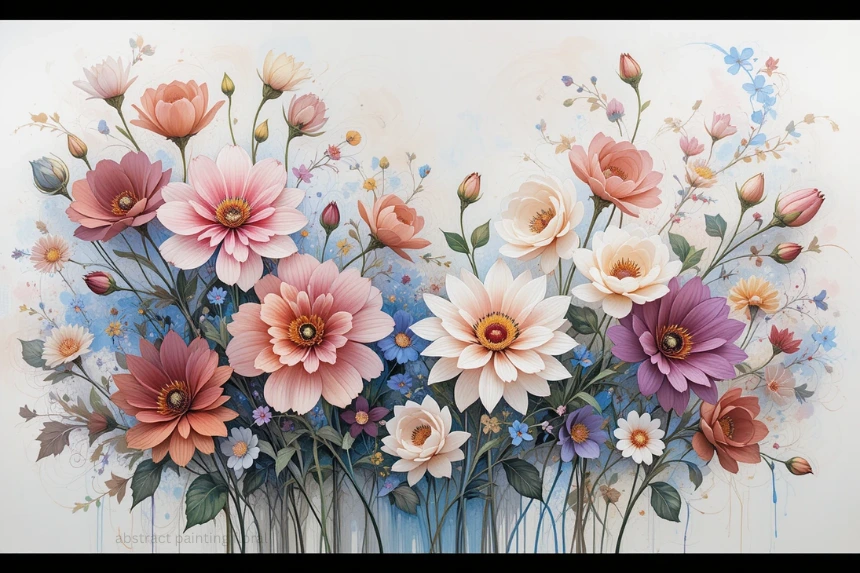Paintings in abstract flower art blends the delicate beauty of flower patterns with the impromptu vitality of abstract expression. This unique genre allows artists to explore emotions, colors, and shapes beyond realistic depictions, creating a captivating visual experience. Knowing the fundamentals and methods of abstract painting flowers will enhance your appreciation and stimulate your creativity, regardless of whether you are an art lover, collector, or budding artist. In this article, we will explore the origins, techniques, themes, and tips for creating stunning abstract painting floral works.
The Origins and Evolution of Abstract Painting Floral
Abstract painting floral art has roots that trace back to early 20th-century modernist movements. Artists like Wassily Kandinsky and Georgia O’Keeffe experimented with blending abstract shapes and floral forms to evoke emotions and deepen symbolic meanings. While O’Keeffe’s floral abstractions highlighted the beauty and vitality of nature in simplified, frequently surreal forms, Kandinsky thought that colors and shapes could elicit spiritual reactions.
Over time, this genre has evolved into a dynamic field where artists freely interpret floral subjects via abstract techniques. The emphasis shifted from exact representations to capturing the essence, mood, and energy of flowers through bold colors, dynamic brushstrokes, and innovative compositions.
Key Characteristics of Abstract Painting Floral
What distinguishes traditional floral art from abstract floral painting? Among the primary characteristics are:
Non-Realistic Forms: Flowers are often stylized, exaggerated, or fragmented rather than depicted realistically.
Expressive Use of Color: Bright, contrasting, or unconventional colors are used emotionally or symbolically.
Dynamic Composition: Movement and flow are emphasized, often with energetic brushstrokes or layered textures.
Focus on Texture and Technique: Artists play with various textures, blending, dripping, or scraping paint for added depth.
Feeling over Detail: The goal is to evoke emotion or mood rather than precise botanical accuracy.
Techniques for Creating Abstract Painting Floral Art
Making floral abstract paintings that have an impact requires a fusion of thoughtful composition and spontaneity. Here are some techniques that artists commonly use:
1. Color Exploration
Color is central to abstract painting floral art. Artists frequently use a color scheme that represents the atmosphere they want to create. Vibrant reds, yellows, and greens can suggest vitality and energy, while muted tones might evoke calm or introspection. Colors can be blended and layered to add depth and vibrancy.
2. Gesture and Brushwork
Energetic brushstrokes or palette knife techniques are employed to convey movement. Quick, bold strokes can form abstract floral shapes, while finer lines might add subtle details or accents.
3. Layering and Texture
Building up layers of paint adds complexity. By scraping, splattering, or combining mixed media like sand, cloth, or paper, artists can experiment with textures. These textures evoke the complexity of flowers.
4. Emphasizing Shapes and Lines
Instead of detailed petals or leaves, abstract floral paintings focus on shapes, curves, and lines. These components direct the viewer’s gaze and bring the picture into harmony.
5. Use of Negative Space
A thoughtful use of negative space draws attention to focal points and balances the picture. Empty areas can serve as a breathing space amidst the energetic forms.
Themes and Symbolism in Abstract Painting Floral
While abstract painting floral emphasizes visual expression over realism, it often carries layered meanings:
Growth and Renewal: Flowers symbolize life cycles, rebirth, and hope.
Emotional Energy: Bright or intense colors convey passion, joy, or chaos.
Nature’s Spirit: Beyond accurate depictions, abstract forms inspire the energy and spirit of nature.
Personal Expression: Artists often embed personal stories or feelings within their floral abstractions.
Exploring Different Floral Motifs
Artists might focus on specific flowers—roses, lilies, or sunflowers—or create more ambiguous floral forms that blend multiple blossoms. The choice influences the emotional tone and visual impact of the artwork.
Tips for Creating Your Own Abstract Painting Floral
If you’re interested in exploring this art form, here are some practical tips:
Start Freely: Don’t aim for perfect shapes. Allow spontaneity and intuition to guide your brush.
Experiment with Colors: Play with different color combinations and observe how they evoke different moods.
Focus on Movement: Use bold, sweeping strokes to convey energy and vitality.
Layer and Build: Don’t be afraid to layer paint and create textures—these add depth.
Combine Media: Incorporate collage, ink, or textured materials to enrich your work.
Trust Your Emotions: Let your feelings influence your choices of color, form, and composition.
Displaying and Appreciating Abstract Painting Floral
Abstract painting floral art makes a striking statement in any space. Softer color schemes produce serene settings, while large canvases with vivid hues can enliven a space. These artworks are often best appreciated when unframed or in minimalist framing that complements the boldness of the piece.
Engaging with abstract floral art involves embracing personal interpretation. Unlike realistic art, its open-ended forms encourage viewers to find their own meaning—a flower’s essence, a burst of emotion, or a reflection of nature’s vitality.
Final Thoughts
Abstract painting floral art offers a rich, expressive avenue for exploring the beauty of nature through abstract forms and vibrant colors. This genre encourages artists and viewers alike to go beyond literal representation and experience the emotional and spiritual qualities of flowers. Whether you’re creating your own masterpiece or appreciating the works of others, embracing the dynamic energy and layered symbolism of abstract floral art opens the door to a deeper understanding of both nature and artistic expression.
Dive into your creative journey with an open mind and let colors, shapes, and textures guide your exploration of abstract painting floral art—where beauty meets imagination in limitless ways.



